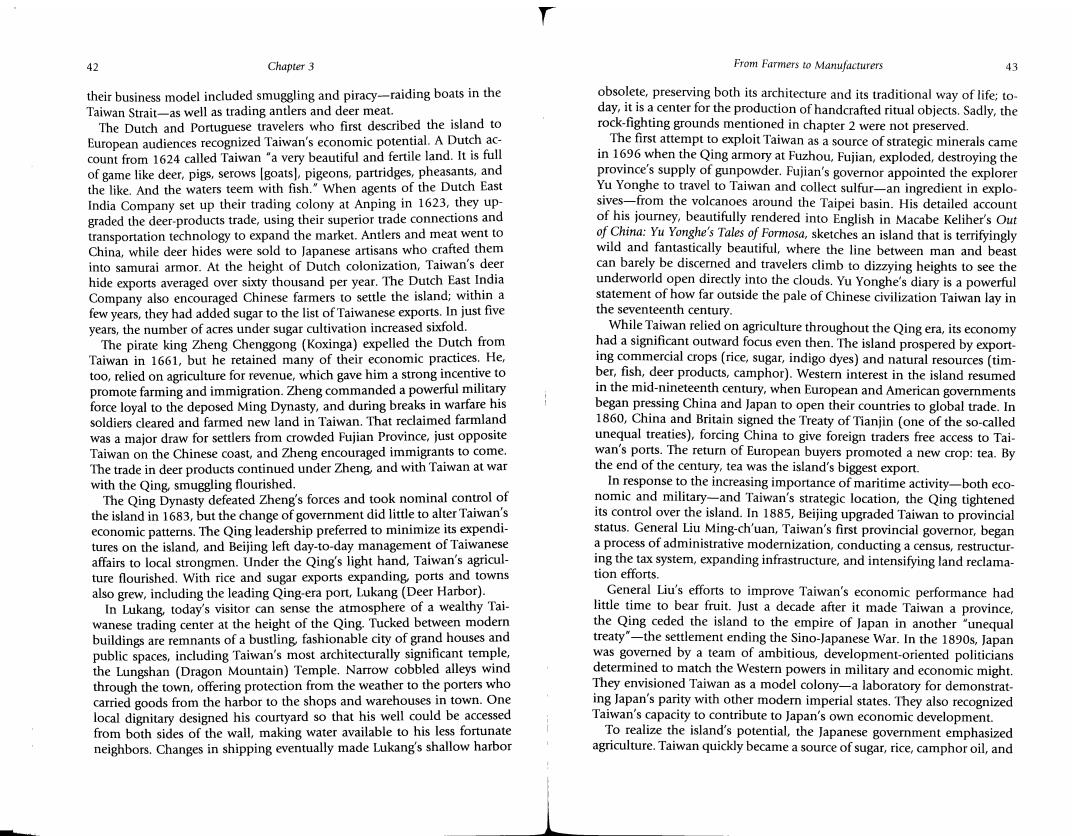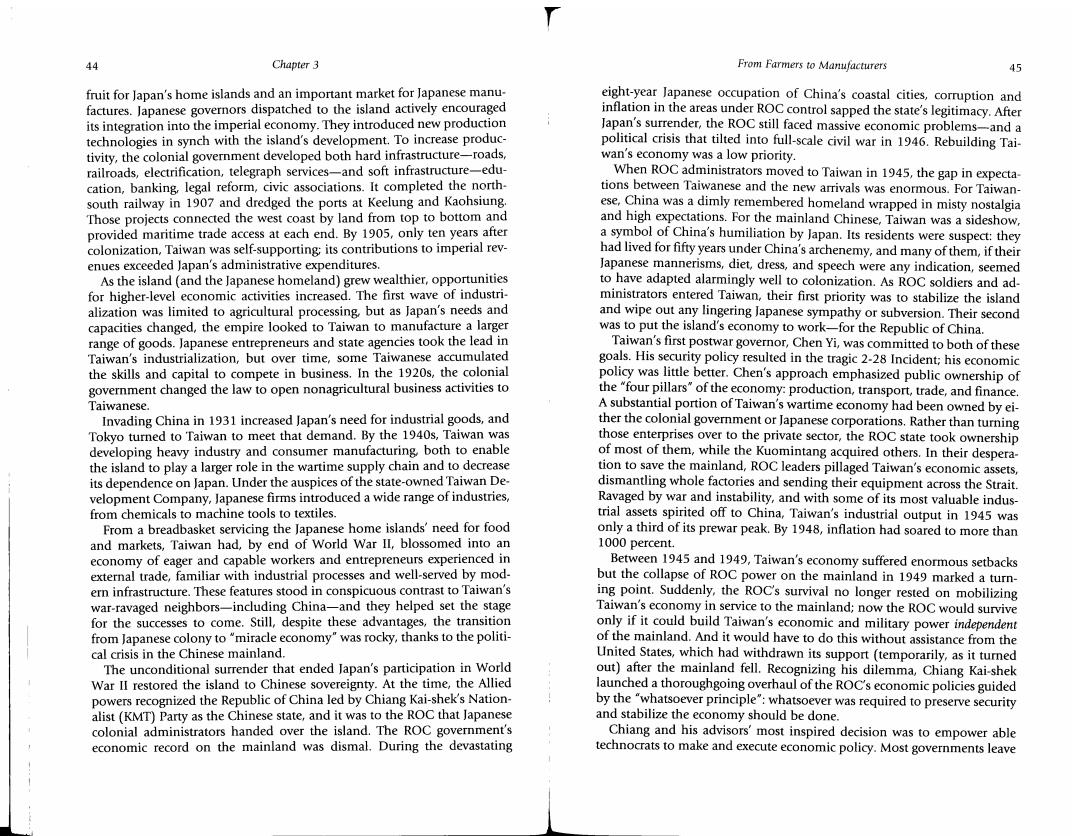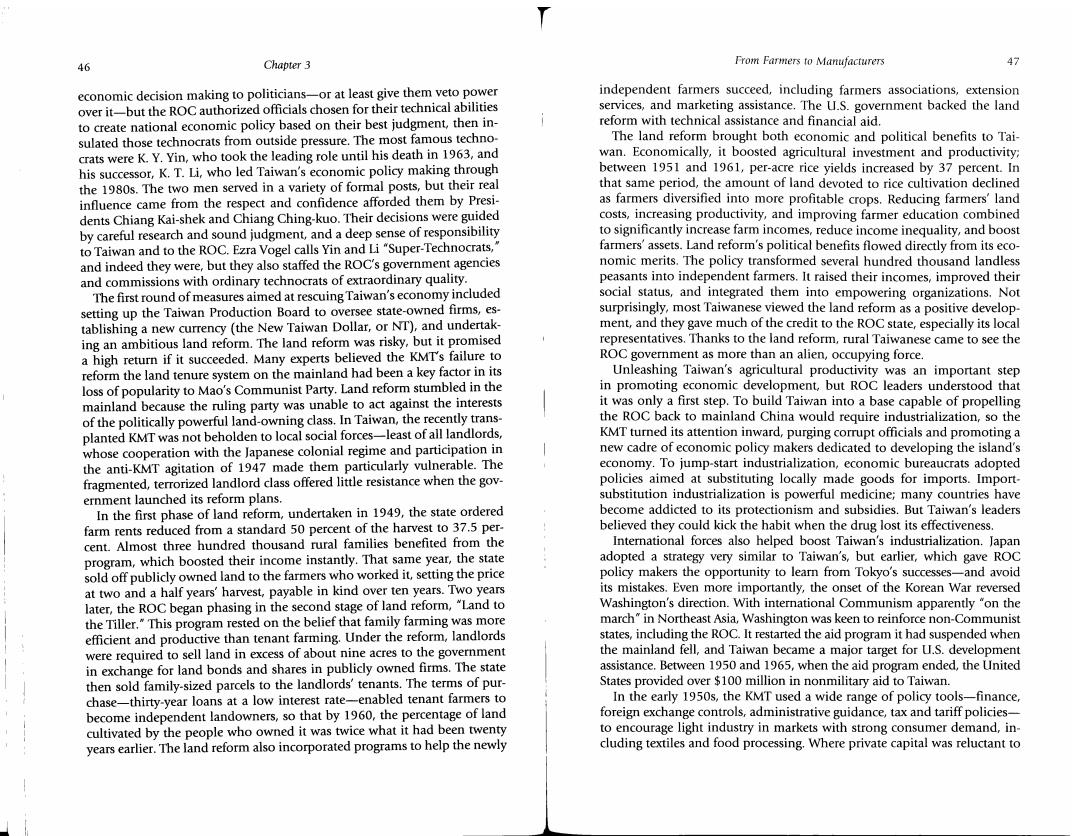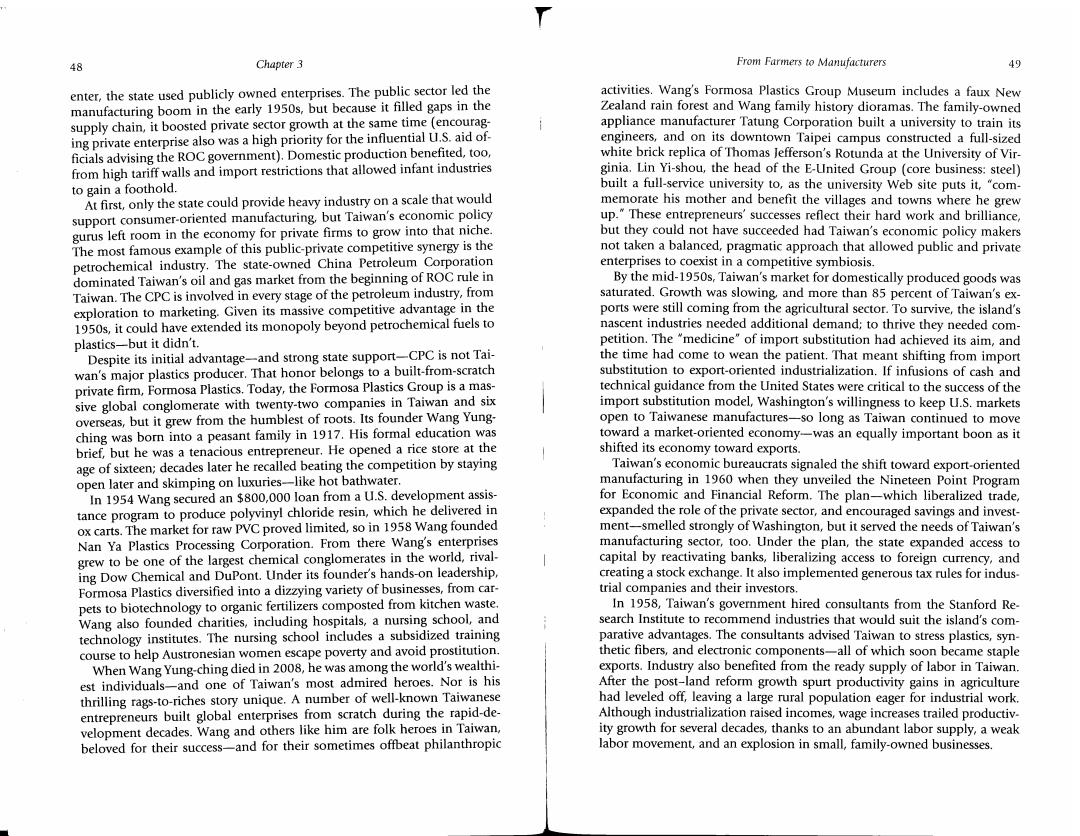
T 3 From Farmers to Manufacturers Taiwan is a small country,but it plays an outsized role in the global economy.It's one of the world's top fifteen trading nations,and its com- panies manufacture a huge share of the information technology that keeps modern societies going:98 percent of computer motherboards,90 percent of notebook PCs,65 percent or more of thin-film transistor-liquid-crystal display (TFT-LCD)screens.A single Taiwanese company-Taiwan Semi- conductor Manufacturing Corporation-makes more than half the world's computer chips,while Acer,Taiwan's first global computer brand,edged past U.S.-based Dell Computer in 2009 to become the world's second- largest seller of notebook PCs. The story of how this tiny island-endowed with few natural resources and a small population-became a global economic powerhouse brings together politics,culture,economics...and a little luck.Together,Taiwan's government and people-its workers,entrepreneurs,farmers,engineers, merchants,and students-earned for their nation the title "Taiwan Mira- cle."They did it by looking outward toward world markets and by staying light on their feet,adjusting constantly to new technologies,new products, new demand.In less than half a century they built a war-torn agrarian back- water into a high-tech superpower. The roots of Taiwan's global outlook run deep.The island's earliest export was a classic specialty product:deer antlers.According to Chinese medical theory,deer antlers cure diseases of the bones,joints,and blood. As early as the 1600s,Austronesian hunters were harvesting wild deer in Taiwan and exchanging them for salt with Chinese traders who delivered them to the mainland as medicine and meat.These earliest Chinese resi- dents lived in the shallow coves and harbors along the island's west coast; 41

42 Chapter 3 From Farmers to Manufacturers 43 their business model included smuggling and piracy-raiding boats in the obsolete,preserving both its architecture and its traditional way of life;to- Taiwan Strait-as well as trading antlers and deer meat. day,it is a center for the production of handcrafted ritual objects.Sadly,the The Dutch and Portuguese travelers who first described the island to rock-fighting grounds mentioned in chapter 2 were not preserved. European audiences recognized Taiwan's economic potential.A Dutch ac- The first attempt to exploit Taiwan as a source of strategic minerals came count from 1624 called Taiwan "a very beautiful and fertile land.It is full in 1696 when the Qing armory at Fuzhou,Fujian,exploded,destroying the of game like deer,pigs,serows lgoats],pigeons,partridges,pheasants,and province's supply of gunpowder.Fujian's governor appointed the explorer the like.And the waters teem with fish."When agents of the Dutch East Yu Yonghe to travel to Taiwan and collect sulfur-an ingredient in explo- India Company set up their trading colony at Anping in 1623,they up- sives-from the volcanoes around the Taipei basin.His detailed account graded the deer-products trade,using their superior trade connections and of his journey,beautifully rendered into English in Macabe Keliher's Out transportation technology to expand the market.Antlers and meat went to of China:Yu Yonghe's Tales of Formosa,sketches an island that is terrifyingly China,while deer hides were sold to Japanese artisans who crafted them wild and fantastically beautiful,where the line between man and beast into samurai armor.At the height of Dutch colonization,Taiwan's deer can barely be discerned and travelers climb to dizzying heights to see the hide exports averaged over sixty thousand per year.The Dutch East India underworld open directly into the clouds.Yu Yonghe's diary is a powerful Company also encouraged Chinese farmers to settle the island;within a statement of how far outside the pale of Chinese civilization Taiwan lay in few years,they had added sugar to the list of Taiwanese exports.In just five the seventeenth century. years,the number of acres under sugar cultivation increased sixfold. While Taiwan relied on agriculture throughout the Qing era,its economy The pirate king Zheng Chenggong(Koxinga)expelled the Dutch from had a significant outward focus even then.The island prospered by export- Taiwan in 1661,but he retained many of their economic practices.He, ing commercial crops(rice,sugar,indigo dyes)and natural resources(tim- too,relied on agriculture for revenue,which gave him a strong incentive to ber,fish,deer products,camphor).Western interest in the island resumed promote farming and immigration.Zheng commanded a powerful military in the mid-nineteenth century,when European and American governments force loyal to the deposed Ming Dynasty,and during breaks in warfare his began pressing China and Japan to open their countries to global trade.In soldiers cleared and farmed new land in Taiwan.That reclaimed farmland 1860,China and Britain signed the Treaty of Tianjin (one of the so-called was a major draw for settlers from crowded Fujian Province,just opposite unequal treaties),forcing China to give foreign traders free access to Tai- Taiwan on the Chinese coast,and Zheng encouraged immigrants to come. wan's ports.The return of European buyers promoted a new crop:tea.By The trade in deer products continued under Zheng,and with Taiwan at war the end of the century,tea was the island's biggest export. with the Qing,smuggling flourished. In response to the increasing importance of maritime activity-both eco- The Qing Dynasty defeated Zheng's forces and took nominal control of nomic and military-and Taiwan's strategic location,the Qing tightened the island in 1683,but the change of government did little to alter Taiwan's its control over the island.In 1885,Beijing upgraded Taiwan to provincial economic patterns.The Qing leadership preferred to minimize its expendi- status.General Liu Ming-ch'uan,Taiwan's first provincial governor,began tures on the island,and Beijing left day-to-day management of Taiwanese a process of administrative modernization,conducting a census,restructur- affairs to local strongmen.Under the Qing's light hand,Taiwan's agricul- ing the tax system,expanding infrastructure,and intensifying land reclama- ture flourished.With rice and sugar exports expanding,ports and towns tion efforts. also grew,including the leading Qing-era port,Lukang (Deer Harbor). General Liu's efforts to improve Taiwan's economic performance had In Lukang,today's visitor can sense the atmosphere of a wealthy Tai- little time to bear fruit.Just a decade after it made Taiwan a province, wanese trading center at the height of the Qing.Tucked between modern the Qing ceded the island to the empire of Japan in another "unequal buildings are remnants of a bustling,fashionable city of grand houses and treaty"-the settlement ending the Sino-Japanese War.In the 1890s,Japan public spaces,including Taiwan's most architecturally significant temple, was governed by a team of ambitious,development-oriented politicians the Lungshan (Dragon Mountain)Temple.Narrow cobbled alleys wind determined to match the Western powers in military and economic might. through the town,offering protection from the weather to the porters who They envisioned Taiwan as a model colony-a laboratory for demonstrat- carried goods from the harbor to the shops and warehouses in town.One ing Japan's parity with other modern imperial states.They also recognized local dignitary designed his courtyard so that his well could be accessed Taiwan's capacity to contribute to Japan's own economic development. from both sides of the wall,making water available to his less fortunate To realize the island's potential,the Japanese government emphasized neighbors.Changes in shipping eventually made Lukang's shallow harbor agriculture.Taiwan quickly became a source of sugar,rice,camphor oil,and

44 Chapter 3 From Farmers to Manufacturers 45 fruit for Japan's home islands and an important market for Japanese manu- eight-year Japanese occupation of China's coastal cities,corruption and factures.Japanese governors dispatched to the island actively encouraged inflation in the areas under ROC control sapped the state's legitimacy.After its integration into the imperial economy.They introduced new production Japan's surrender,the ROC still faced massive economic problems-and a technologies in synch with the island's development.To increase produc- political crisis that tilted into full-scale civil war in 1946.Rebuilding Tai- tivity,the colonial government developed both hard infrastructure-roads, wan's economy was a low priority. railroads,electrification,telegraph services-and soft infrastructure-edu- When ROC administrators moved to Taiwan in 1945,the gap in expecta- cation,banking,legal reform,civic associations.It completed the north- tions between Taiwanese and the new arrivals was enormous.For Taiwan- south railway in 1907 and dredged the ports at Keelung and Kaohsiung. ese,China was a dimly remembered homeland wrapped in misty nostalgia Those projects connected the west coast by land from top to bottom and and high expectations.For the mainland Chinese,Taiwan was a sideshow, provided maritime trade access at each end.By 1905,only ten years after a symbol of China's humiliation by Japan.Its residents were suspect:they colonization,Taiwan was self-supporting;its contributions to imperial rev- had lived for fifty years under China's archenemy,and many of them,if their enues exceeded Japan's administrative expenditures. Japanese mannerisms,diet,dress,and speech were any indication,seemed As the island (and the Japanese homeland)grew wealthier,opportunities to have adapted alarmingly well to colonization.As ROC soldiers and ad- for higher-level economic activities increased.The first wave of industri- ministrators entered Taiwan,their first priority was to stabilize the island alization was limited to agricultural processing,but as Japan's needs and and wipe out any lingering Japanese sympathy or subversion.Their second capacities changed,the empire looked to Taiwan to manufacture a larger was to put the island's economy to work-for the Republic of China. range of goods.Japanese entrepreneurs and state agencies took the lead in Taiwan's first postwar governor,Chen Yi,was committed to both of these Taiwan's industrialization,but over time,some Taiwanese accumulated goals.His security policy resulted in the tragic 2-28 Incident;his economic the skills and capital to compete in business.In the 1920s,the colonial policy was little better.Chen's approach emphasized public ownership of government changed the law to open nonagricultural business activities to the "four pillars"of the economy:production,transport,trade,and finance. Taiwanese. A substantial portion of Taiwan's wartime economy had been owned by ei- Invading China in 1931 increased Japan's need for industrial goods,and ther the colonial government or Japanese corporations.Rather than turning Tokyo turned to Taiwan to meet that demand.By the 1940s,Taiwan was those enterprises over to the private sector,the ROC state took ownership developing heavy industry and consumer manufacturing,both to enable of most of them,while the Kuomintang acquired others.In their despera- the island to play a larger role in the wartime supply chain and to decrease tion to save the mainland,ROC leaders pillaged Taiwan's economic assets, its dependence on Japan.Under the auspices of the state-owned Taiwan De- dismantling whole factories and sending their equipment across the Strait. velopment Company,Japanese firms introduced a wide range of industries, Ravaged by war and instability,and with some of its most valuable indus- from chemicals to machine tools to textiles. trial assets spirited off to China,Taiwan's industrial output in 1945 was From a breadbasket servicing the Japanese home islands'need for food only a third of its prewar peak.By 1948,inflation had soared to more than and markets,Taiwan had,by end of World War Il,blossomed into an 1000 percent. economy of eager and capable workers and entrepreneurs experienced in Between 1945 and 1949,Taiwan's economy suffered enormous setbacks external trade,familiar with industrial processes and well-served by mod- but the collapse of ROC power on the mainland in 1949 marked a turn- ern infrastructure.These features stood in conspicuous contrast to Taiwan's ing point.Suddenly,the ROC's survival no longer rested on mobilizing war-ravaged neighbors-including China-and they helped set the stage Taiwan's economy in service to the mainland;now the ROC would survive for the successes to come.Still,despite these advantages,the transition only if it could build Taiwan's economic and military power independent from Japanese colony to "miracle economy"was rocky,thanks to the politi- of the mainland.And it would have to do this without assistance from the cal crisis in the Chinese mainland. United States,which had withdrawn its support(temporarily,as it turned The unconditional surrender that ended Japan's participation in World out)after the mainland fell.Recognizing his dilemma,Chiang Kai-shek War II restored the island to Chinese sovereignty.At the time,the Allied launched a thoroughgoing overhaul of the ROC's economic policies guided powers recognized the Republic of China led by Chiang Kai-shek's Nation- by the "whatsoever principle":whatsoever was required to preserve security alist(KMT)Party as the Chinese state,and it was to the ROC that Japanese and stabilize the economy should be done. colonial administrators handed over the island.The ROC government's Chiang and his advisors'most inspired decision was to empower able economic record on the mainland was dismal.During the devastating technocrats to make and execute economic policy.Most governments leave

46 Chapter 3 From Farmers to Manufacturers 9> economic decision making to politicians-or at least give them veto power independent farmers succeed,including farmers associations,extension over it-but the ROC authorized officials chosen for their technical abilities services,and marketing assistance.The U.S.government backed the land to create national economic policy based on their best judgment,then in- reform with technical assistance and financial aid. sulated those technocrats from outside pressure.The most famous techno- The land reform brought both economic and political benefits to Tai- crats were K.Y.Yin,who took the leading role until his death in 1963,and wan.Economically,it boosted agricultural investment and productivity: his successor,K.T.Li,who led Taiwan's economic policy making through between 1951 and 1961,per-acre rice yields increased by 37 percent.In the 1980s.The two men served in a variety of formal posts,but their real that same period,the amount of land devoted to rice cultivation declined influence came from the respect and confidence afforded them by Presi- as farmers diversified into more profitable crops.Reducing farmers'land dents Chiang Kai-shek and Chiang Ching-kuo.Their decisions were guided costs,increasing productivity,and improving farmer education combined by careful research and sound judgment,and a deep sense of responsibility to significantly increase farm incomes,reduce income inequality,and boost to Taiwan and to the ROC.Ezra Vogel calls Yin and Li "Super-Technocrats," farmers'assets.Land reform's political benefits flowed directly from its eco- and indeed they were,but they also staffed the ROC's government agencies nomic merits.The policy transformed several hundred thousand landless and commissions with ordinary technocrats of extraordinary quality. peasants into independent farmers.It raised their incomes,improved their The first round of measures aimed at rescuing Taiwan's economy included social status,and integrated them into empowering organizations.Not setting up the Taiwan Production Board to oversee state-owned firms,es- surprisingly,most Taiwanese viewed the land reform as a positive develop- tablishing a new currency (the New Taiwan Dollar,or NT),and undertak- ment,and they gave much of the credit to the ROC state,especially its local ing an ambitious land reform.The land reform was risky,but it promised representatives.Thanks to the land reform,rural Taiwanese came to see the a high return if it succeeded.Many experts believed the KMT's failure to ROC government as more than an alien,occupying force. reform the land tenure system on the mainland had been a key factor in its Unleashing Taiwan's agricultural productivity was an important step loss of popularity to Mao's Communist Party.Land reform stumbled in the in promoting economic development,but ROC leaders understood that mainland because the ruling party was unable to act against the interests it was only a first step.To build Taiwan into a base capable of propelling of the politically powerful land-owning class.In Taiwan,the recently trans- the ROC back to mainland China would require industrialization,so the planted KMT was not beholden to local social forces-least of all landlords, KMT turned its attention inward,purging corrupt officials and promoting a whose cooperation with the Japanese colonial regime and participation in new cadre of economic policy makers dedicated to developing the island's the anti-KMT agitation of 1947 made them particularly vulnerable.The economy.To jump-start industrialization,economic bureaucrats adopted fragmented,terrorized landlord class offered little resistance when the gov- policies aimed at substituting locally made goods for imports.Import- ernment launched its reform plans. substitution industrialization is powerful medicine;many countries have In the first phase of land reform,undertaken in 1949,the state ordered become addicted to its protectionism and subsidies.But Taiwan's leaders farm rents reduced from a standard 50 percent of the harvest to 37.5 per- believed they could kick the habit when the drug lost its effectiveness. cent.Almost three hundred thousand rural families benefited from the International forces also helped boost Taiwan's industrialization.Japan program,which boosted their income instantly.That same year,the state adopted a strategy very similar to Taiwan's,but earlier,which gave ROC sold off publicly owned land to the farmers who worked it,setting the price policy makers the opportunity to learn from Tokyo's successes-and avoid at two and a half years'harvest,payable in kind over ten years.Two years its mistakes.Even more importantly,the onset of the Korean War reversed later,the ROC began phasing in the second stage of land reform,"Land to Washington's direction.With international Communism apparently "on the the Tiller."This program rested on the belief that family farming was more march"in Northeast Asia,Washington was keen to reinforce non-Communist efficient and productive than tenant farming.Under the reform,landlords states,including the ROC.It restarted the aid program it had suspended when were required to sell land in excess of about nine acres to the government the mainland fell,and Taiwan became a major target for U.S.development in exchange for land bonds and shares in publicly owned firms.The state assistance.Between 1950 and 1965,when the aid program ended,the United then sold family-sized parcels to the landlords'tenants.The terms of pur- States provided over $100 million in nonmilitary aid to Taiwan. chase-thirty-year loans at a low interest rate-enabled tenant farmers to In the early 1950s,the KMT used a wide range of policy tools-finance, become independent landowners,so that by 1960,the percentage of land foreign exchange controls,administrative guidance,tax and tariff policies- cultivated by the people who owned it was twice what it had been twenty to encourage light industry in markets with strong consumer demand,in- years earlier.The land reform also incorporated programs to help the newly cluding textiles and food processing.Where private capital was reluctant to

48 Chapter 3 From Farmers to Manufacturers 49 enter,the state used publicly owned enterprises.The public sector led the activities.Wang's Formosa Plastics Group Museum includes a faux New manufacturing boom in the early 1950s,but because it filled gaps in the Zealand rain forest and Wang family history dioramas.The family-owned supply chain,it boosted private sector growth at the same time (encourag- appliance manufacturer Tatung Corporation built a university to train its ing private enterprise also was a high priority for the influential U.S.aid of- engineers,and on its downtown Taipei campus constructed a full-sized ficials advising the ROC government).Domestic production benefited,too, white brick replica of Thomas lefferson's Rotunda at the University of Vir- from high tariff walls and import restrictions that allowed infant industries ginia.Lin Yi-shou,the head of the E-United Group (core business:steel) to gain a foothold. built a full-service university to,as the university Web site puts it,"com- At first,only the state could provide heavy industry on a scale that would memorate his mother and benefit the villages and towns where he grew support consumer-oriented manufacturing,but Taiwan's economic policy up."These entrepreneurs'successes reflect their hard work and brilliance, gurus left room in the economy for private firms to grow into that niche. but they could not have succeeded had Taiwan's economic policy makers The most famous example of this public-private competitive synergy is the not taken a balanced,pragmatic approach that allowed public and private petrochemical industry.The state-owned China Petroleum Corporation enterprises to coexist in a competitive symbiosis. dominated Taiwan's oil and gas market from the beginning of ROC rule in By the mid-1950s,Taiwan's market for domestically produced goods was Taiwan.The CPC is involved in every stage of the petroleum industry,from saturated.Growth was slowing,and more than 85 percent of Taiwan's ex- exploration to marketing.Given its massive competitive advantage in the ports were still coming from the agricultural sector.To survive,the island's 1950s,it could have extended its monopoly beyond petrochemical fuels to nascent industries needed additional demand;to thrive they needed com- plastics-but it didn't. petition.The "medicine"of import substitution had achieved its aim,and Despite its initial advantage-and strong state support-CPC is not Tai- the time had come to wean the patient.That meant shifting from import wan's major plastics producer.That honor belongs to a built-from-scratch substitution to export-oriented industrialization.If infusions of cash and private firm,Formosa Plastics.Today,the Formosa Plastics Group is a mas- technical guidance from the United States were critical to the success of the sive global conglomerate with twenty-two companies in Taiwan and six import substitution model,Washington's willingness to keep U.S.markets overseas,but it grew from the humblest of roots.Its founder Wang Yung- open to Taiwanese manufactures-so long as Taiwan continued to move ching was born into a peasant family in 1917.His formal education was toward a market-oriented economy-was an equally important boon as it brief,but he was a tenacious entrepreneur.He opened a rice store at the shifted its economy toward exports. age of sixteen;decades later he recalled beating the competition by staying Taiwan's economic bureaucrats signaled the shift toward export-oriented open later and skimping on luxuries-like hot bathwater. manufacturing in 1960 when they unveiled the Nineteen Point Program In 1954 Wang secured an $800,000 loan from a U.S.development assis- for Economic and Financial Reform.The plan-which liberalized trade, tance program to produce polyvinyl chloride resin,which he delivered in expanded the role of the private sector,and encouraged savings and invest- ox carts.The market for raw PVC proved limited,so in 1958 Wang founded ment-smelled strongly of Washington,but it served the needs of Taiwan's Nan Ya Plastics Processing Corporation.From there Wang's enterprises manufacturing sector,too.Under the plan,the state expanded access to grew to be one of the largest chemical conglomerates in the world,rival- capital by reactivating banks,liberalizing access to foreign currency,and ing Dow Chemical and DuPont.Under its founder's hands-on leadership, creating a stock exchange.It also implemented generous tax rules for indus- Formosa Plastics diversified into a dizzying variety of businesses,from car- trial companies and their investors. pets to biotechnology to organic fertilizers composted from kitchen waste. In 1958,Taiwan's government hired consultants from the Stanford Re- Wang also founded charities,including hospitals,a nursing school,and search Institute to recommend industries that would suit the island's com- technology institutes.The nursing school includes a subsidized training parative advantages.The consultants advised Taiwan to stress plastics,syn- course to help Austronesian women escape poverty and avoid prostitution. thetic fibers,and electronic components-all of which soon became staple When Wang Yung-ching died in 2008,he was among the world's wealthi- exports.Industry also benefited from the ready supply of labor in Taiwan. est individuals-and one of Taiwan's most admired heroes.Nor is his After the post-land reform growth spurt productivity gains in agriculture thrilling rags-to-riches story unique.A number of well-known Taiwanese had leveled off,leaving a large rural population eager for industrial work. entrepreneurs built global enterprises from scratch during the rapid-de- Although industrialization raised incomes,wage increases trailed productiv- velopment decades.Wang and others like him are folk heroes in Taiwan, ity growth for several decades,thanks to an abundant labor supply,a weak beloved for their success-and for their sometimes offbeat philanthropic labor movement,and an explosion in small,family-owned businesses